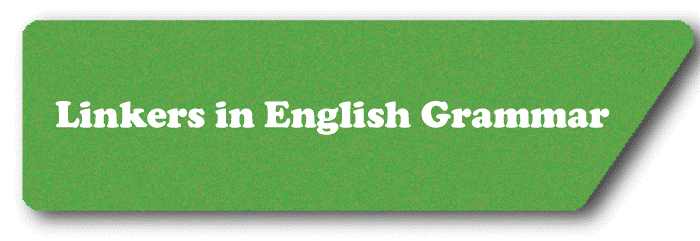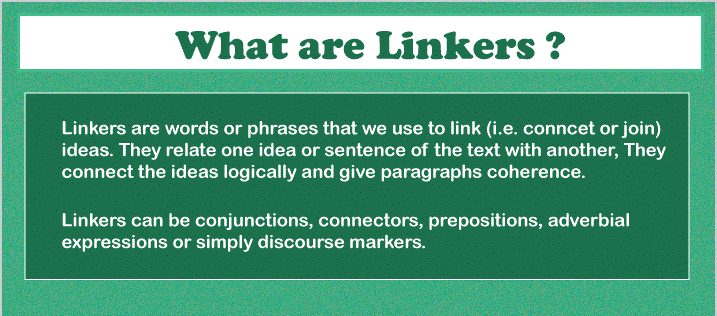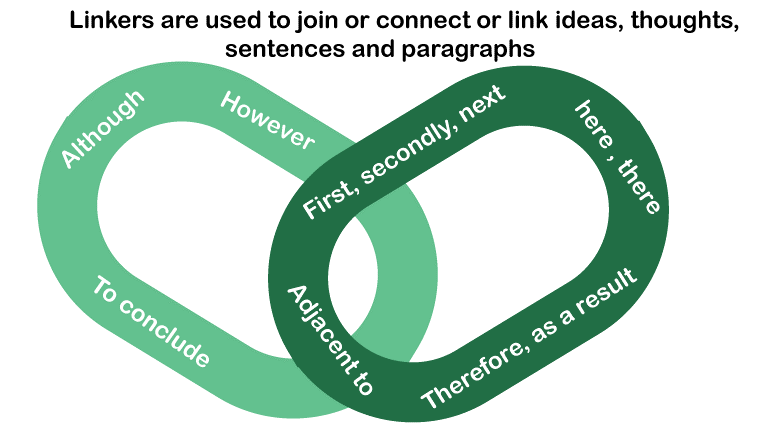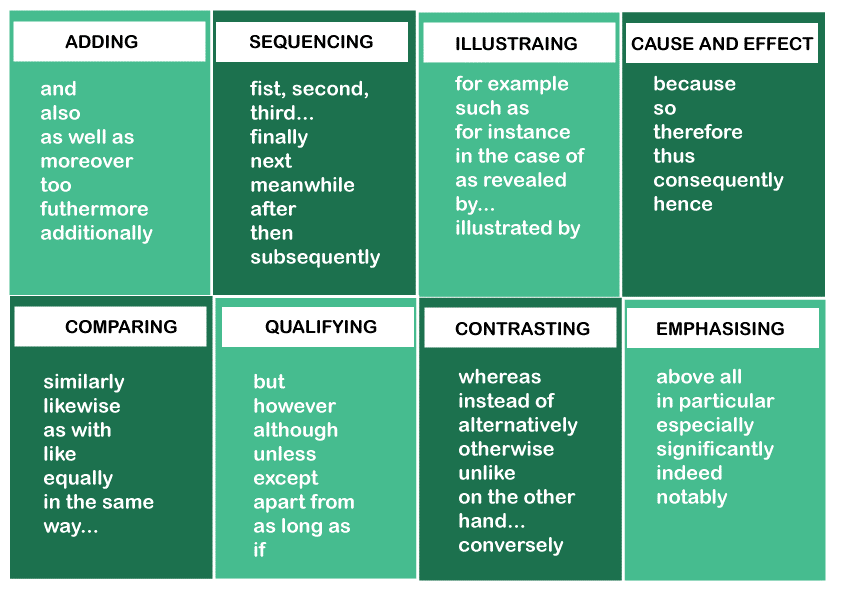Linkers in English GrammarIn English, linkers are statements or words that connect your work. It aids in the formation of a logical relationship between paragraphs or concepts. They are frequently inserted in the middle or at the start of a sentence. Words or phrases that link words, phrases, sentences, concepts, or paragraphs are known as linkers. Connectors and linking words are other terms for linkers. In English, for example, the three primary linkers are and, because, and but. 
Linkers are typically used at the start or halfway of a sentence. They are used to connect two or more clauses or statements. The first concept, 'Storm was forecast,' is the explanation for the second idea, 'I stayed in school,' in this instance. Alternatively, 'I stayed in school' is the outcome for the event - storm was forecast. To clarify the two notions, both of these statements can be linked using linkers: hence or so. Example: Storm was forecast, so I stayed in school. A storm was forecast. Therefore/ As a result, I stayed at school. The order is changeable. We may utilize the linker 'because' to place the outcome before the cause. Example: I stayed at school because a storm was forecast. Linkers serve several tasks in a sentence. They are utilized to contrast, compare, define, exemplify, and summarise ideas, as well as to construct concise paragraphs. 
Types of LinkersThe following are examples of different types of linkers, along with their purpose, linking phrases or words, and their usage in sentences: Addition: This type of linker adds support to the main idea. It can be linked by using phrases such as 'and', 'even', 'also', 'furthermore', and 'in addition'. Example: Sheela participated in the drawing competition, and in addition to that, she also enjoys playing music. Comparison: This type of linker determines the similarities between two ideas. It can be linked using phrases such as 'similarly', 'likewise', 'by comparison', and 'in the same way'. Example: I was late to work, and similarly, my wife got delayed too. Contrast: This type of linker shows the difference between two ideas. It can be linked using phrases such as 'but', 'yet', 'however', and 'in contrast'. Example: Though we arrived on time, the doors were closed. Time: This type of linker indicates the time and regularity of events. It can be linked using phrases such as 'at once', 'in the meantime', 'when', and 'while'. Example: She slept while I mopped the house. Example: This type of linker provides illustrations to support the main idea. It can be linked using phrases such as 'for example', 'such as', and 'to illustrate'. Example: This medicine can treat various diseases such as pneumonia and bronchitis. Place: This type of linker indicates the position of a noun. It can be linked using phrases such as 'here', 'there', 'next to', and 'opposite to'. Example: He lived in a house adjacent to the temple. Summary: This type of linker draws a conclusion by summarizing the core ideas. It can be linked using phrases such as 'in brief', 'on the whole', and 'to sum up'. Example: On the whole, I am satisfied with what I have achieved so far in life. Result: This type of linker shows a reason and its end result. It can be linked using phrases such as 'as a result', 'therefore', and 'consequently'. Example: A storm was predicted. Therefore, I resided at school. Sequence: This type of linker shows ideas listed on a priority basis. It can be linked using phrases such as 'first', 'second', 'then', and 'finally'. Example: His dinner got spoiled; consequently, he threw it all away. Which Connecting Words Should You Use in Descriptive Writing?Look at the ones listed above to learn about the different types of linkers and how they are utilised in descriptive writing. To produce an effective essay or story, employ suitable linkers in your paragraphs and phrases. Common MistakesConnecting words are not required. If you overdo them, the reader may become confused. When providing further evidence supporting an argument addressed in a preceding sentence, linking words such as in particular, furthermore, moreover, and in addition must be utilised. It should not be used to signify the beginning of a similar idea in the text or paragraph. After employing linking words at the start of a phrase, use a comma. Example: However, I had different goals that afternoon. A semi-colon is put after the first sentence when connecting words are used to link two clauses. Example: We would like to join you all for the celebration; however we are not free today. The term "linkers" refers to terms or phrases that connect sentences or clauses. Linkers or connectives are classified into two types: conjunctions and linking adverbs. Do not mix up the terms. ExceptionsNot all linkers appear at the start or midway of a sentence. Time linkers can also be used to terminate a statement. They should not be used in the middle of a statement. Examples: Next week, my spring break will begin. (This is correct. ) My spring break will begin the next week. (But, this sentence is more suitable. ) When discussing the prior day, do not use the last day. When referring to a prior day, the phrase 'yesterday' is appropriate. Examples: I saw the recently released film yesterday. I saw the recently released film the last day. Avoided using yesterday night. 'Last night' is the proper time linker phrase. Examples: I couldn't sleep well last night. I couldn't sleep well the yesterday night. One Sentence or Two SentencesYou'll note that we can connect two ideas in a single sentence or two. Your decision will usually be determined by the complexity of each notion and whether you are talking or writing. In spoken English, simple ideas are frequently combined with simple linkers such as and, but, because, and so: I felt exhausted, so I went to sleep early. In written English, more complicated ideas are frequently combined in two statements: The disadvantages of migrating to a new location on the shore are significant. As a result, we urge that the present Dublin premises be retained for the time being. When we connect concepts in a single sentence, each idea has a clause, and the linker is frequently a conjunction: The conjunctions and, but, so, while, whereas, and although are used to unite concepts as clauses in a single sentence. Yet, on the other hand, thus, furthermore, and so on are adverbs that connect ideas in two statements. Linkers, Both Formal and InformalIn spoken English, informal linking words are utilised. You can connect your thoughts with words and phrases such as: I mean, honestly, after all, aside, and in any case. It is beneficial to understand which linking terms are most suitable in formal and casual contexts. In an email, you could utilise linking words like so, but, and because. These ought to be known to you. In an article, formal linkers like therefore, however, consequently, on the contrary, and additionally are more likely to be used. Some linking terms are so professional that you may want to avoid using them in your writing. Hence, thus, and nonetheless are some examples. 
PunctuationIt is critical to employ punctuation with certain linking terms and phrases. Several grammar texts include precise rules for punctuation and sentence clauses. The most crucial reason for utilising punctuation in a sentence is to ensure that the reader understands what you mean. Punctuation, especially commas, must assist the reader in identifying clauses in your work and lead to a better understanding of the content. Which of these two example statements is easiest to understand? A: To summarise, future cars are anticipated to be more ecologically friendly; however, this transition may take several years to achieve and will also require widespread support. B: To summarise, future cars are anticipated to be more ecologically friendly; however, this transition may take several years to achieve and will also need widespread approval. In written writings, linking words are extremely crucial. Your writing may be disjointed and hard to follow without them. Students' ability to produce cohesive statements is frequently graded in English exams. As a result, understanding how to effectively employ linking words is a crucial skill in learning English as a second dialect. Meanings And Applications of WordsConjunctions are a common type of connecting word that connects two clauses in a statement, such as but, because, or however. Indeed, linking words serve a variety of functions in a sentence, ranging from single terms to phrases of up to four words. The following categories illustrate the most prevalent types of linking words. SequencingFirst, second, third, and finally First, second, and lastly appear at the beginning of a statement. They assist the reader in navigating through the content. They are utilized in essays as well as instructions, such as recipes. Adding informationFurthermore, additionally, in addition, what is more These connecting words are utilised to provide more information or to enhance our argument. ComparisonSimilarly, equally, likewise We utilise connecting words to provide additional instances or to connect topics. Giving examplesAs an example, consider the phrase, such as, for instance To provide instances, use these linking terms. ConsequenceConsequently, therefore, as a result, hence These linking terms may be utilized to describe how one thought follows others rationally. In your writing, try to incorporate a range of linking terms. Don't use the same linker throughout your essay! GeneralisationOverall, generally, typically These connecting words are frequently used at the beginning of a phrase. They come before a broad statement. To summariseto sum, to summarise, to conclude, in conclusion These phrases are frequently used to begin the final part of an essay. They are also employed in formal spoken English, such as a speech or on the news, to alert the listener that the speech is approaching to a conclusion. ContrastingYet, on the other hand, in comparison, rather, whereas, while These linking words are used to establish a new idea or argument that contrasts with previous statements. They are helpful in an essay for presenting, say, the negatives in an advantages and disadvantages essay. The word rather is used in this context in a formal way. 
Stating factActually, as a matter of fact These linking words might be used to inform the reader that the writer's meaning differs from what the reader anticipates. ConcessionNonetheless, despite, in spite of that These linking words are utilized to convey that we respect another person's viewpoint, even if we disagree with it. Tips for using linkers in English GrammarConjunctions, often known as linkers, are an important part of English grammar. These are words or phrases that link clauses, phrases, or statements together, assisting in the creation of a logical and cohesive flow of ideas. Here are some pointers on how to use linkers in English grammar:
Finally, linkers are an important part of English grammar since they help to build consistency and connect ideas. You may generate better ordered and interesting communication by learning the various sorts of linkers and applying them effectively in your writing and voice.
Next TopicCase In English Grammar
|
 For Videos Join Our Youtube Channel: Join Now
For Videos Join Our Youtube Channel: Join Now
Feedback
- Send your Feedback to [email protected]
Help Others, Please Share










